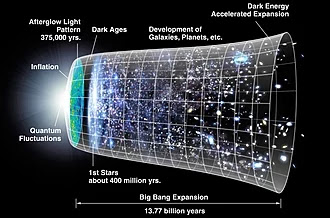The Big Bang
We see around many different objects in our daily life. Everything we see and observe is a part of this universe. Have you ever wondered how this universe came into existence? Well, there are many different theories and predictions which were made in the earliest years and still going on in present. The one accepted widely by most of the scientists is "The Big Bang Theory". The big bang theory is the cosmological model of the universe which describes how the universe came into existence and expanded. It is also considered as the event by which the universe came into existence, or the birth of universe. Calculations and measurements of the expansion rate of universe, places the big bang at around 13.8 billion years ago which is also considered as the age of the universe. The big bang states that the universe began with an infinitely dense point at an infinite temperature. This point is called as "Singularity" which was a few millimeters wide. At about 13.7 billion years ago this tiny singularity exploded violently and from this explosion the matter, energy, space and time were created as they are today. After the explosion of the singularity the evolution of the universe is divided into two stages namely, The Radiation Era: Dominance of Radiation over Matter; and The Matter Era: Dominance of Matter over Radiation. Let's go into their brief explanations.
RADIATION ERA
The first stage which existed right after the Big Bang was the radiation era where the radiation dominated over matter. Now for better understanding this stage is divided into further smaller stages of the universe which occurred within the first seconds of the creation of the universe. This Stages are called Epochs and they are Planck Epoch, Grand unified epoch, inflationary epoch, electroweak epoch, quark epoch, hadron epoch, lepton and nuclear epoch.
- PLANCK EPOCH
The earliest stage of the universe immediately after the big bang is the Planck Epoch. At this stage no matter existed in the universe. It had only Energy and the Superforce ( Combination of 4 natural forces i.e Gravity, strong nuclear, weak nuclear and electromagnetic ). At the end of this stage the Gravity was split away from the superforce. The temperature of the universe was about 1040 kelvin.
 |
| IMGS SOURCE: National Geographic |
- GRAND UNIFICATION EPOCH
The next stage is the grand unification epoch which was named from the unification of the three remaining forces, the strong nuclear force, weak nuclear force and electromagnetic force. This stage occurred after 10-44 seconds after the big bang. The temperature at this stage was about 1036 kelvin. At the end of this stage the strong nuclear force split away from the other 2 forces. However the first atoms or sub-atomic particles were not formed even at this stage and the universe continued to cool down.
- INFLATIONARY EPOCH
After the grand unification epoch the inflationary epoch began. This stage occurred after 10-36 seconds after the big bang. At this stage the universe started expanding rapidly. It almost expanded from the size of an atom to size of an apple instantly in no time. The universe at this stage formed the first electrons, quarks and other tiny particles from a very high energy density and huge temperatures and pressures and was rapidly expanding and cooling. The temperature at this stage was cooled down to 1033 kelvin. The particles formed at this stage are also known as seeds that grew into large structures of the universe.
- ELECTROWEAK EPOCH
Then came the electroweak epoch just after 10-32 seconds after the big bang where the temperature rapidly cooled down to 1016 kelvin. In this stage the last two forces, the electromagnetic and the weak nuclear forces finally split off and the universe got its four natural forces. This was the period of the universe where the all the particles of an atom were formed but were not combined.
- QUARK EPOCH
This stage was the beginning of the formation of the sub atomic particles after 10-12 seconds of the big bang, all the particles were formed and they beginning of the formation of the first atoms started. However it was not completed even at the end of this stage. The temperature of the universe was about 1016 kelvin.
- HADRON EPOCH
- LEPTON AND NUCLEAR EPOCH
The Radiation Era lasted 100 seconds after the big bang and the temperature dropped from 1040 kelvin to 109 kelvin. This era gave the universe its first chemical element which is Helium. This is the reason why helium is known as the oldest element from the periodic table. This era is also known as the inflation period as the universe expanded from nothing to such a huge entity.
MATTER ERA
After the radiation era, matter era started where the matter began to dominate over radiation. The universe now has the ability to create matter by combining the sub atomic particles which is the main cause of existence of matter. This matter era is divided into three stages or epochs known as the Atomic Epoch, Galactic Epoch and Stellar Epoch. This era spans a life time of billions of years and is still lasting. Let's start with
- ATOMIC EPOCH
The temperature of the universe cooled down to 3000 kelvin and was enough for electrons to attach to the nuclei also called as recombination. This process gave the universe its second chemical element i.e Hydrogen (H). This way the universe created all other atoms and all the elements came into existence. This stage occurred after 50,000 years of the big bang.
- GALACTIC EPOCH
Their was abundance of hydrogen and helium atoms for them to combine and form clouds. Within the clouds the gravity caused atoms to collect and form the solid masses also called seedlings of the galaxies. This stage occurred after 200 million years of the big bang. The temperature was cooled down enough for clouds to become hard masses. The heat transitions caused hydrogen and helium to form and combine all the elements which we know till date.
- STELLAR EPOCH
Inside these Galaxies stars and planets began to form by combination of matter. These stars, planets, combined together and shaped the galaxies. This stage occurred after billions of years of the big bang. The stellar epoch is the present stage of the universe with over 200 billion galaxies. These stars, planets, galaxies and other masses shaped the universe as we know it today. These elements became the key components in building Planets, moons, stars, asteroids, life and every observable matter we see today.
 |
The Big Bang theory is considered to be true as per calculations based on the theory of relativity and Hubble's Law, however it is still not possible to say that the universe existed exactly the same way as the theory says. The theory explained above is not exactly the same as it was before, many advances were made to the theory as the technology increased and as we came to know more about space. The evidences of the big bang is the discovery of CMBR ( Cosmic Microwave Background Radiation ). CMB is an electromagnetic radiation which is said to be remnant from an early stage of the universe. CMBR fills all the empty space which was predicted by Ralph Alpher and Robert Herman and later was proved by Wilson and Penzias for which they received the Noble Prize in Physics in 1978.
 |
| Cosmic Microwave Background Radiation |
So this was a brief explanation of the big bang for an easy understanding as it has importance in modern technology. However, people still believe that universe is created by a creator but science will not accept it as it is not proved, funny right? This is a huge controversy among atheists and religious people which i think, cannot be solved and the mystery of the creation of universe remains same. Many theories will come and go but I surely believe that when there is a creation there must be a creator!!
Comment Your Views And Suggestions :)












99% correct, just hydrogen first (1 proton/neutron & electron), then helium (2 p/n & e).
ReplyDelete